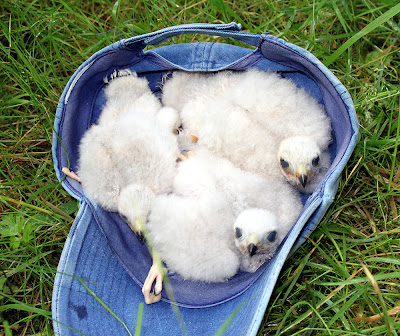We approached this morning’s ringing session with some apprehension as it was our first for a month, the four weeks interval devoted to bemoaning our luck with the continuous bad weather of a so called “summer”.
We were right to be cautious in our expectations with a four hour session yielding just 9 birds of which three only were juveniles. Last year we ringed over 130 Whitethroats in this prime warbler location at Out Rawcliffe, today nil Whitethroats. The seven new birds comprised 4 Blackcap (3 adults) and 1 each of Wren, Robin and Willow Warbler. The Wren and Robin were juveniles, the Willow Warbler an adult in heavy moult, the moult indicating a bird which has completed its (probably unsuccessful) breeding season. Two recaptures were a Blackbird and a Dunnock.
Blackcap
Willow Warbler
Robin
Birding wise was equally quiet, a noticeable feature being an early morning movement of Siskins heading south with a minimum of six individuals. Others: 1 Kestrel, 1 Little Owl, 3 Corn Bunting, 4 Yellowhammer, 2 Reed Bunting, 15 Goldfinch, 8 Linnet, 2 Great-spotted Woodpecker.
Readers of a squeamish disposition should maybe skip the next gruesome paragraph and picture because there’s a reasonable shot of a Grey Heron at the end of the post.
In between bouts of netting boredom Will and I mooched about, looking at butterfly larvae, reminiscing about the summer ringing of 2011or then searching the sky for Swallows, when we came across the fresh entrails of an animal. Not far away we found the corpse, a headless, partly eaten Brown Hare. Countryman Will explained how a Fox had killed the animal, and unable to carry the heavy carcass off, had eaten a meal but would be back later for another helping of now slightly less fresh meat. OK it’s a grisly tale but at least it’s filled another paragraph about an otherwise dismal session.
Brown Hare
Brown Hare
This was another grey, wet and miserable morning when I looked out of the window hoping for a spot of sunshine but spotted the Grey Heron on a neighbour’s roof. They do say that herons often land on wet roofs as from a distance they mistake the shiny surface for an expanse of water. Well there have been plenty of those around lately.
Grey Heron
Now excuse me as I really must get back to my evening meal, but more from Another Bird Blog soon.







































































